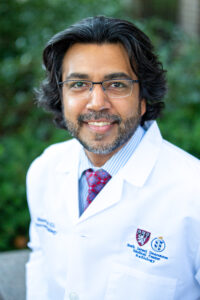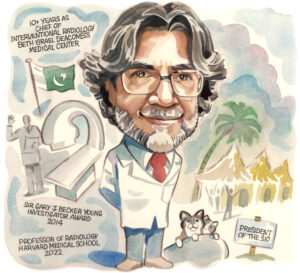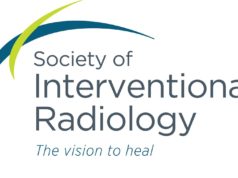
Tracing back his line to interventional radiology (IR), Muneeb Ahmed, interventional radiologist and the current president of the Society of Interventional Oncology (SIO), told Interventional News of how he followed in the footsteps of his father, Rashid Ahmed, an influential interventional radiologist who propelled the field in Pakistan. Guided to IR, Ahmed’s career has driven research and innovation, and, throughout his presidency, Ahmed has sought the global expansion of the interventional oncology (IO) community and furthered clinical discovery via SIO-led clinical trials. As his term concludes, he reflects on these accomplishments and his continued commitment to advancing the field of IO.
What attracted you to a career in IR?
I have known IR as a field from a young age, both with regards to its impact on patients, and to its novelty and innovation. My father, Rashid Ahmed, was an interventional radiologist who trained in the USA before moving back to Pakistan, his home country, to develop both diagnostic and interventional radiology as fields within that country. Throughout his 35-year career there, he introduced a multitude of new procedures and types of imaging studies in the country, established new training programmes, started a national radiology society and journal, trained several generations of diagnostic and interventional radiologists, and was ultimately recognised by the government for his service with one of the highest national civilian awards. All this while, he was passionate for learning new techniques, and happiest when he had performed a life-saving procedure on a patient. I remember watching him perform angiography and embolization, talking with him about his cases, and meeting his grateful patients. This passion for continuous learning in IR left a significant impression on me.
When I had the chance to work within IR, and more specifically interventional oncology (IO), I understood his excitement for the field. There were so many different procedures to learn, a wide range of diseases to understand, and the technological advances seemed endless. By the time I was deciding on fellowship, IR was the clear and only choice, and I haven’t looked back since. IR has fulfilled that promise, as I continue to be excited about where the field is going, and all of the new and innovative treatments that are being developed.
Who were your mentors throughout your career?
I have been fortunate to have had several important mentors who have provided very important opportunities, guidance, and support at critical steps in my career-to-date. The earliest was Melvin Clouse, a world-renowned interventional radiologist at Beth Israel Deaconess Medical Center (BIDMC) in Boston, USA, who involved me in summer research programmes as a medical student from Pakistan, and encouraged my interests in scientific research, and ultimately in radiology.
One of the key introductions he made was to a young Nahum Goldberg, who was just starting out as an attending consultant at BIDMC and doing innovative research in percutaneous tumour ablation with radiofrequency energy. From that point onwards, through a three-year post-doctoral research fellowship, and in the over 25 years since, we continued to work together on our shared research to advance the field of image-guided tumour ablation. Nahum has been my key mentor throughout this time, instilling a passion for research, providing advice at critical career decision points, and serving as a role model for how to build an academic career.
More recently, I have also benefited from mentors that I have met later in my career. Fred Lee shared his insights in leadership and entrepreneurship during my time as a division chief. Through my volunteerism with the SIO, I have also been able to follow amazing examples of societal leaders in Matt Callstrom and Bill Rilling, both of whom have provided me with valuable mentorship.
I have appreciated each of these mentors, and sought to emulate and honour their generosity by providing similar opportunities, support, and guidance to younger interventional radiologists who are trying to develop successful careers in IR.
Is there a memorable case that stands out to you?
Many years ago, I started treating a patient with metastatic renal cell cancer who had already survived six years following a nephrectomy and various immunotherapies. He stood out at the time for his positivity and enthusiasm for life, his desire to find the right balance between his quality of life and longevity, and his faith in and excitement for new and emerging therapies (he received interleukin therapy as part of early clinical trials in renal cell carcinoma). When I first met him, he had developed isolated metastases in his single kidney—for which I performed a successful cryoablation. Over the next eight years, I treated additional metastasis in his liver, lung, and adrenal gland—and we were able to keep his cancer at bay through intermittent IO therapies, including repeated ablation and embolization. He ultimately succumbed to his disease, but after living his life to the fullest and with happiness and excitement. When his family reflected on his experiences after he passed away, the thing that they were most thankful for from the various minimally-invasive treatment options that he received over the years, was that he always had hope. Hope, even near the end of life, is an important thing that IR often offers even when patients receive news that their cancer has progressed through other therapies. When I think about him, I remember that it’s important to appreciate what we can do for people’s happiness—the importance of kindness and empathy, and the value of IR done well on a patient’s life.
You have published several research papers in 2024. Which of your recent endeavours has been the most insightful?
I firmly believe that we need to advance IR through a multi-pronged research approach, developing early ideas, proving their clinical efficacy (starting with proof-of-concept studies and progressing through to robust prospective clinical trials), and then tackling barriers to widespread clinical implementation such as cost-effectiveness and utilization research, and then training the next generation of interventional radiologists. I am excited about all of the research projects coming out of the BIDMC IR team in recent years— tackling questions at each of the various phases I mentioned. If I had to pick, the work that my partner Jeff Weinstein and I are doing on studying an operator’s hand motion while doing IR procedures is very interesting, as it provides us with insight into how interventional radiologists learn. This work will hopefully provide objective measures to assess technical skill acquisition and design better training methods in IR.
Similarly, I am also excited about our recent study with percutaneous cryoablation for locally recurrent prostate cancer—Vijay Ramalingam et al in the Journal of Vascular and Interventional Radiology (JVIR) 2024—as this incorporates a computed-tomography (CT) guided approach to treating focal prostate bed cancer recurrences that can be expanded and used at many centres overcoming resource-limitations that are associated with previously reported magnetic resonance imaging (MRI) guidance based techniques. Focusing on ways to make IO therapies accessible to a wider range of patients is something that I am very passionate about.
 As your presidency of the SIO comes to a close, what have been your greatest achievements?
As your presidency of the SIO comes to a close, what have been your greatest achievements?
Two years as SIO president has flown by! The society team, including all of the volunteers and the staff (under Jena Stack’s extremely capable leadership) continues to accomplish so much. I am very excited that we have gotten the ACCLAIM trial off the ground and well on its way to completion, and are now planning additional trials. We have expanded our society membership through key global partnerships and are continuing to build collaborations with other societies on joint projects. We have continued to develop and offer the highest calibre of meeting content— last year’s SIO 2024 annual meeting having been one of our most successful meetings yet, and we have an exciting programme planned for 2025. Our most recent SIO Masterclass in musculoskeletal IO, a unique hands-on immersion-style programme that we recently held here at BIDMC, was also exciting and very successful.
At the beginning of my presidency, a priority was to strengthen IO’s global voice. We have made a lot of progress towards this goal. One of our key objectives has been to implement a ‘big-tent’ philosophy within the SIO, and specifically that anyone involved in the IO space—whether performing IO or wanting to learn more about IO—has a place in our society. To this end, we have created global SIO chapters through partnerships with different societies around the world, including the Middle East, creation of our Asia-Oceanic chapter and most recently with creation of our Latin American chapter. This has led to closer collaboration in these regions, and a growth in the SIO’s membership to over 1,300 members worldwide.
Overall, I am most proud of the extremely energetic and growing group of volunteers that we are attracting to the SIO—without whom we would not be able to continue to advance the IO space on many fronts. Success begets success.
How is the ACCLAIM trial progressing?
I am very excited about the ACCLAIM trial— we are making great progress! Thanks goes to Constantinos T Sofocleous, the trial’s global principal investigator, all of the volunteers who are involved in the trial, and the SIO staff team that is overseeing trial operations. We have opened 10 international sites, and have already recruited over half of the necessary patients, ahead of our original schedule, and look to close out patient recruitment by the fall of 2025. This is a pivotal prospective study that incorporates formal ablation margin confirmation as the technical endpoint to performing ablation for colorectal liver metastases, and the successful completion will provide necessary evidence to help us establish use of margin confirmation as the standard of care when performing liver ablation. This is the first multi-industry supported trial in our space, and the first that the SIO has developed and initiated, so I am particularly proud that we have been able to execute this so well.
Have any recent research papers caught your attention in the last 12 months?
I am very excited about the recent presentation of the COLLISION trial—a phase three randomised multicentre study comparing surgical resection and percutaneous thermal ablation for small liver-only colorectal cancer metastases led by Martjin Meijerink and colleagues from Amsterdam University Medical Center. This study stands out to me for how well it was designed and executed, how it incorporated many of the lessons that we have learned about thermal ablation over the years, including the importance of achieving a documented appropriate ablation margin (>1cm for colorectal metastases), use of contrast-enhanced margin assessment, and re-ablating patients where an adequate ablative margin was not achieved. To me, this underscores how the IO community has grown in the field—implementing high-quality studies that prove that our therapies offer patients excellent outcomes in a safer and better tolerated manner. The study team is to be commended, and I look forward to reading the full published manuscript when it becomes available.
What are your hobbies and interests outside of medicine?
As I am originally from Karachi, Pakistan, I enjoy travelling to new places around the world. Some of my most enjoyable trips have been to the Mediterranean, Mallorca, and the Maldives. I enjoy reading and spending time with my family, including my wife, Susan, my two children, Saif and Sofia, and our two snowshoe cats.












